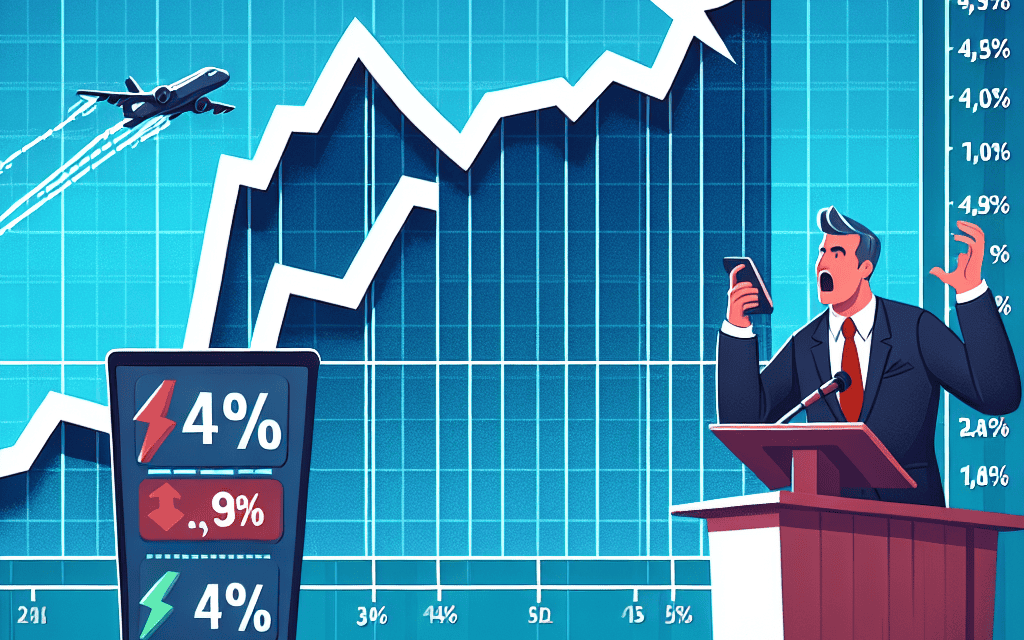“Market Momentum: Dow Jones Rises as Trump Stocks Soar; Super Micro Tackles Sharp Decline”
Introduction
On Election Day, the Dow Jones Industrial Average experienced a notable climb, driven in part by a surge in stocks associated with former President Donald Trump. This market movement reflects investor reactions to the unfolding political landscape and its potential economic implications. Meanwhile, Super Micro Computer Inc. is set to address a significant 45% plunge in its stock value, capturing the attention of market analysts and investors alike. These developments are part of a dynamic day in the financial markets, with live updates providing insights into the factors influencing stock performance and broader economic trends.
Impact Of Election Day On Stock Markets: A Historical Perspective
The impact of Election Day on stock markets has long been a subject of interest for investors and analysts alike. Historically, the stock market’s performance on and around Election Day can be influenced by a variety of factors, including investor sentiment, economic policies proposed by candidates, and the overall political climate. As the nation turns its attention to the polls, the Dow Jones Industrial Average often reflects the prevailing mood, with fluctuations that can be attributed to the anticipation of election outcomes and their potential economic implications.
In examining the historical perspective, it is evident that stock markets tend to experience heightened volatility during election periods. This is largely due to the uncertainty surrounding potential policy changes that could affect various sectors of the economy. For instance, markets may react positively to candidates perceived as business-friendly, while the prospect of increased regulation or taxation under other candidates might lead to a more cautious approach from investors. Consequently, the Dow Jones, along with other major indices, often sees significant movement as investors attempt to position themselves advantageously in response to anticipated policy shifts.
The 2020 election serves as a pertinent example of this phenomenon. Leading up to Election Day, the stock market experienced a series of fluctuations as investors weighed the potential outcomes and their implications for fiscal policy, trade agreements, and regulatory frameworks. The uncertainty was further compounded by the unprecedented circumstances of the COVID-19 pandemic, which added an additional layer of complexity to the economic landscape. As a result, the Dow Jones saw both surges and declines as the election drew nearer, reflecting the market’s sensitivity to political developments.
Moreover, the influence of Election Day on stock markets is not limited to domestic factors. Global markets also keep a keen eye on U.S. elections, given the country’s significant role in the global economy. International investors often adjust their portfolios in response to U.S. election outcomes, which can lead to ripple effects across global markets. This interconnectedness underscores the importance of understanding the historical patterns of market behavior during election periods, as it provides valuable insights for both domestic and international investors.
In addition to the broader market trends, individual stocks can also experience notable movements on Election Day. Companies that are closely tied to specific policies or industries may see their stock prices react sharply to election results. For example, a company in the renewable energy sector might experience a surge in stock price if a candidate with a strong environmental agenda is elected. Conversely, a company reliant on fossil fuels might face a decline if the election outcome suggests a shift towards stricter environmental regulations.
As we consider the historical impact of Election Day on stock markets, it is crucial to recognize the role of investor psychology. The anticipation and uncertainty surrounding elections can lead to emotional decision-making, which in turn influences market behavior. Understanding these psychological factors, alongside the economic and political considerations, provides a comprehensive view of how elections shape market dynamics.
In conclusion, the historical perspective on the impact of Election Day on stock markets reveals a complex interplay of factors that drive market behavior. From investor sentiment and policy expectations to global economic considerations, the influence of elections on stock markets is multifaceted and significant. As we observe the Dow Jones climbing amid the Trump stock surge on Election Day, it is a reminder of the enduring connection between political events and market performance, a relationship that continues to captivate the attention of investors worldwide.
Analyzing The Trump Stock Surge: Factors And Implications
On Election Day, the Dow Jones Industrial Average experienced a notable climb, driven in part by a surge in stocks associated with former President Donald Trump. This unexpected market movement has captured the attention of investors and analysts alike, prompting a closer examination of the factors contributing to this surge and its broader implications for the financial markets. As the day unfolded, the spotlight was not only on the election results but also on the performance of specific stocks that have become emblematic of Trump’s influence in the business world.
One of the primary factors behind the Trump stock surge is the anticipation of potential policy shifts that could favor businesses linked to the former president. Investors are speculating that a favorable election outcome for Trump-aligned candidates might lead to regulatory changes or economic policies that could benefit these companies. This speculation has fueled a wave of optimism, driving up stock prices as investors position themselves to capitalize on potential future gains. Moreover, Trump’s continued presence in the political arena has kept his brand and associated businesses in the public eye, further amplifying investor interest.
In addition to political considerations, the Trump stock surge can also be attributed to broader market dynamics. The stock market often reacts to uncertainty with volatility, and Election Day is no exception. As investors seek to navigate the unpredictable landscape, they may gravitate towards stocks perceived as having a strong connection to influential political figures. This behavior underscores the complex interplay between politics and the financial markets, where perceptions and expectations can significantly impact stock performance.
While the Trump stock surge has captured headlines, it is essential to consider its implications within the broader context of the market. The rise in these stocks has contributed to the overall upward momentum of the Dow Jones, reflecting a sense of optimism among investors. However, this optimism is tempered by caution, as market participants remain vigilant about potential risks and uncertainties. The outcome of the election, along with subsequent policy decisions, will play a crucial role in shaping the market’s trajectory in the coming months.
Amidst this backdrop, Super Micro, a company unrelated to the Trump stock surge, has announced plans to address a significant 45% plunge in its stock value. This development serves as a reminder of the diverse factors influencing individual stock performance, beyond political considerations. Super Micro’s response to its stock decline will be closely watched by investors, as it may offer insights into how companies navigate challenges and seek to restore investor confidence.
In conclusion, the Trump stock surge on Election Day highlights the intricate relationship between politics and the financial markets. While investor optimism has driven up stock prices, the broader implications of this surge remain uncertain. As the election results unfold and policy directions become clearer, market participants will continue to assess the potential impact on their investment strategies. Meanwhile, companies like Super Micro must address their unique challenges, demonstrating the multifaceted nature of the stock market. As always, investors are advised to remain informed and vigilant, considering both political and economic factors as they navigate the ever-evolving landscape of the financial markets.
Dow Jones Performance: Key Drivers Behind The Climb
The Dow Jones Industrial Average experienced a notable climb on Election Day, driven by a surge in stocks associated with former President Donald Trump. This upward movement in the market reflects a complex interplay of political and economic factors that have captured the attention of investors and analysts alike. As the nation turned its focus to the polls, the stock market responded with a degree of optimism, buoyed by the performance of companies linked to Trump’s business ventures and political influence.
One of the primary drivers behind the Dow’s ascent was the remarkable performance of Trump-affiliated stocks. These companies, which have often been subject to volatility due to the former president’s polarizing presence, saw a significant uptick in their market value. Investors appeared to be betting on the potential for favorable policy outcomes and business opportunities should Trump’s political influence continue to grow. This surge in stock prices was not only a reflection of investor sentiment but also an indication of the broader market’s sensitivity to political developments.
In addition to the Trump-related stock surge, the overall economic landscape played a crucial role in the Dow’s performance. The U.S. economy has been navigating a complex recovery from the disruptions caused by the COVID-19 pandemic, and recent economic indicators have shown signs of resilience. Employment figures, consumer spending, and corporate earnings reports have all contributed to a more optimistic outlook, providing a solid foundation for the stock market’s upward trajectory. As investors assessed these economic signals, confidence in the market’s ability to sustain growth was bolstered, further fueling the Dow’s climb.
Moreover, the Federal Reserve’s monetary policy stance has continued to influence market dynamics. With interest rates remaining relatively low, borrowing costs have been kept in check, encouraging both consumer spending and business investment. This accommodative monetary environment has been a key factor in supporting the stock market’s performance, as it provides a favorable backdrop for economic expansion. As a result, investors have been more willing to take on risk, contributing to the positive momentum observed in the Dow Jones Industrial Average.
While the Dow’s climb was a cause for optimism, not all sectors shared in the gains. Super Micro, a prominent player in the technology sector, faced a significant challenge as its stock plunged by 45%. This sharp decline was attributed to a combination of factors, including supply chain disruptions and concerns over future earnings potential. In response to this dramatic drop, Super Micro announced plans to address the situation, aiming to reassure investors and stabilize its market position. The company’s efforts to mitigate the impact of these challenges will be closely watched by market participants, as they seek to understand the broader implications for the technology sector.
In conclusion, the Dow Jones Industrial Average’s climb on Election Day was driven by a confluence of factors, including the surge in Trump-affiliated stocks, positive economic indicators, and supportive monetary policy. While the market’s performance was generally positive, the challenges faced by companies like Super Micro highlight the complexities and uncertainties that continue to shape the investment landscape. As investors navigate these dynamics, the interplay between political developments, economic conditions, and corporate performance will remain central to understanding the future trajectory of the stock market.
Super Micro’s 45% Plunge: Causes And Company Response

On a day marked by significant movements in the stock market, the Dow Jones Industrial Average experienced a notable climb, driven in part by a surge in stocks associated with former President Donald Trump. However, amidst this upward trend, Super Micro Computer Inc. faced a stark contrast as its shares plummeted by 45%. This dramatic decline has prompted both investors and analysts to scrutinize the underlying causes and anticipate the company’s response to this financial setback.
The precipitous drop in Super Micro’s stock can be attributed to a confluence of factors that have raised concerns among stakeholders. Primarily, the company recently reported earnings that fell short of market expectations, triggering a wave of investor anxiety. Despite efforts to expand its market presence and enhance its product offerings, Super Micro’s financial performance has not aligned with the optimistic projections set forth by analysts. This discrepancy has led to a reevaluation of the company’s growth trajectory and its ability to navigate the competitive landscape of the technology sector.
Moreover, the broader economic environment has also played a role in exacerbating Super Micro’s challenges. With ongoing supply chain disruptions and fluctuating demand patterns, the technology industry has been grappling with uncertainties that have impacted production schedules and cost structures. Super Micro, like many of its peers, has faced difficulties in securing critical components, leading to delays in product delivery and increased operational costs. These external pressures have compounded the company’s internal struggles, further contributing to the decline in its stock value.
In response to this significant downturn, Super Micro has taken proactive measures to address investor concerns and stabilize its financial standing. The company’s leadership has emphasized a commitment to transparency and open communication, aiming to rebuild trust with shareholders. As part of this effort, Super Micro has announced a comprehensive review of its operational strategies, with a focus on optimizing supply chain management and enhancing cost efficiency. By identifying areas for improvement and implementing targeted initiatives, the company seeks to mitigate the impact of external challenges and strengthen its competitive position.
Additionally, Super Micro is exploring opportunities for strategic partnerships and collaborations to bolster its market presence and drive innovation. By leveraging synergies with other industry players, the company aims to expand its product portfolio and tap into emerging market trends. This forward-looking approach reflects Super Micro’s determination to adapt to evolving industry dynamics and capitalize on growth opportunities.
While the road to recovery may be fraught with challenges, Super Micro’s response to its current predicament underscores a commitment to resilience and adaptability. The company’s efforts to address the root causes of its stock plunge and implement corrective measures demonstrate a proactive stance in navigating the complexities of the technology sector. As Super Micro continues to engage with stakeholders and refine its strategic direction, the coming months will be crucial in determining the effectiveness of its response and the potential for a rebound in its stock performance.
In conclusion, the 45% plunge in Super Micro’s stock serves as a stark reminder of the volatility inherent in the technology industry and the importance of strategic agility. As the company endeavors to address its current challenges and chart a path forward, its actions will be closely monitored by investors and analysts alike. Through a combination of transparency, strategic partnerships, and operational improvements, Super Micro aims to restore confidence and position itself for sustainable growth in the future.
Investor Strategies During Political Uncertainty
In the ever-evolving landscape of financial markets, political events often serve as significant catalysts for market movements. The recent surge in the Dow Jones Industrial Average, coinciding with a notable rise in stocks associated with former President Donald Trump on Election Day, underscores the intricate relationship between politics and market dynamics. As investors navigate these turbulent waters, understanding the implications of political uncertainty becomes paramount.
Political events, such as elections, can introduce a level of unpredictability that affects investor sentiment and market behavior. The recent uptick in the Dow Jones, driven in part by a surge in Trump-affiliated stocks, highlights how political figures and their associated entities can influence market trends. This phenomenon is not isolated; rather, it reflects a broader pattern where markets react to the potential policy changes and economic directions signaled by political developments. Consequently, investors must remain vigilant, adapting their strategies to account for the potential volatility that accompanies such events.
In the context of the current market environment, the performance of Trump-related stocks serves as a case study in how political affiliations can impact investor behavior. The surge in these stocks suggests that investors are speculating on the potential benefits that a political comeback could bring to businesses associated with Trump. This speculation is fueled by the belief that certain policies or regulatory changes could favor these companies, thereby enhancing their profitability. However, it is crucial for investors to exercise caution, as such speculative moves can be fraught with risk, particularly if the anticipated political outcomes do not materialize.
Amidst this backdrop of political uncertainty, the case of Super Micro, which experienced a dramatic 45% plunge, further illustrates the challenges investors face. The company’s significant decline serves as a reminder of the inherent risks in the market, especially when external factors such as political developments come into play. For investors, this underscores the importance of diversification and risk management. By spreading investments across a range of assets and sectors, investors can mitigate the impact of unforeseen events on their portfolios.
Moreover, the current scenario highlights the need for investors to stay informed and agile. Keeping abreast of political developments and understanding their potential implications for the market is essential. This involves not only monitoring news and updates but also analyzing how different sectors and companies might be affected by changes in the political landscape. By doing so, investors can make more informed decisions, positioning themselves to capitalize on opportunities while minimizing risks.
In conclusion, the recent movements in the Dow Jones and the fluctuations in Trump-related stocks underscore the profound impact that political events can have on financial markets. As investors navigate this period of uncertainty, adopting a strategic approach that emphasizes diversification, risk management, and informed decision-making is crucial. By remaining vigilant and adaptable, investors can better position themselves to weather the storms of political uncertainty and potentially reap the rewards of a well-considered investment strategy. As the market continues to respond to the evolving political landscape, the ability to anticipate and adapt to these changes will be a defining factor in achieving long-term investment success.
The Role Of Technology Stocks In Market Volatility
The role of technology stocks in market volatility has become increasingly significant, particularly as the Dow Jones Industrial Average experiences fluctuations influenced by political events and corporate developments. On Election Day, the Dow Jones climbed, buoyed by a surge in stocks associated with former President Donald Trump. This phenomenon underscores the intricate relationship between political dynamics and market behavior, highlighting how investor sentiment can be swayed by the potential implications of election outcomes on economic policies and business environments.
Technology stocks, often seen as the bellwethers of market sentiment, play a pivotal role in this landscape. Their inherent volatility can amplify broader market movements, as they are sensitive to both macroeconomic indicators and sector-specific developments. For instance, the recent 45% plunge in Super Micro’s stock serves as a stark reminder of how quickly fortunes can change in the tech sector. This decline, attributed to concerns over supply chain disruptions and competitive pressures, illustrates the vulnerability of tech companies to external shocks and the rapid dissemination of information in today’s digital age.
Moreover, the tech sector’s influence on market volatility is further compounded by its substantial representation in major indices. As technology companies continue to dominate the market capitalization of indices like the S&P 500 and the Nasdaq Composite, their performance can significantly sway overall market trends. This concentration means that any significant movement in tech stocks, whether due to earnings reports, regulatory changes, or geopolitical tensions, can have outsized effects on market indices and investor portfolios.
In addition to these factors, the rapid pace of innovation within the technology sector contributes to its volatility. Companies are constantly striving to outpace competitors through advancements in artificial intelligence, cloud computing, and other cutting-edge technologies. While this drive for innovation can lead to substantial growth opportunities, it also introduces a level of uncertainty as investors attempt to gauge which companies will emerge as leaders in the next wave of technological breakthroughs.
Furthermore, the global nature of the technology industry adds another layer of complexity to its impact on market volatility. With supply chains and customer bases that span continents, tech companies are particularly susceptible to international trade policies and geopolitical tensions. For example, ongoing trade disputes or regulatory changes in key markets can lead to abrupt shifts in stock prices, as investors reassess the potential risks and rewards associated with these developments.
As we consider the role of technology stocks in market volatility, it is essential to recognize the interplay between investor psychology and market dynamics. The tech sector’s reputation for rapid growth and innovation can attract speculative investment, leading to heightened volatility as investors react to news and trends with increased fervor. This behavior can create feedback loops, where initial price movements are exacerbated by subsequent buying or selling, further amplifying market swings.
In conclusion, technology stocks are a critical driver of market volatility, influenced by a myriad of factors ranging from political events and corporate performance to innovation and global economic conditions. As the Dow Jones climbs amid a Trump stock surge on Election Day and Super Micro addresses its significant stock plunge, the intricate relationship between technology stocks and market volatility remains a focal point for investors seeking to navigate the complexities of today’s financial landscape. Understanding this dynamic is crucial for making informed investment decisions and anticipating potential market shifts in an ever-evolving economic environment.
Live Updates: Real-Time Analysis Of Market Movements On Election Day
As the nation turns its attention to the pivotal Election Day, the financial markets are responding with notable movements, reflecting the anticipation and uncertainty that accompany such a significant event. The Dow Jones Industrial Average has experienced a climb, buoyed by a surge in stocks associated with former President Donald Trump. This unexpected rise in Trump-related stocks has captured the attention of investors and analysts alike, as they seek to understand the underlying factors driving this trend. Meanwhile, Super Micro, a key player in the technology sector, is grappling with a substantial 45% plunge in its stock value, prompting the company to address investor concerns and provide clarity on the situation.
The upward trajectory of the Dow Jones can be attributed, in part, to the renewed interest in Trump-affiliated companies. This surge is likely fueled by speculation regarding potential policy shifts and economic strategies that could emerge from the election results. Investors are keenly aware of the impact that political outcomes can have on market dynamics, and the current environment is no exception. As a result, there is a palpable sense of anticipation as market participants await further developments and insights into the election’s implications for the business landscape.
In contrast, Super Micro’s significant decline has raised eyebrows and prompted questions about the company’s current standing and future prospects. The 45% drop in stock value is a stark reminder of the volatility that can characterize the technology sector, particularly in times of heightened uncertainty. In response to this dramatic downturn, Super Micro is expected to address the situation by providing a comprehensive analysis of the factors contributing to the decline. This move is aimed at reassuring investors and stakeholders, as well as outlining a strategic path forward to regain stability and confidence in the market.
As the day unfolds, real-time analysis of market movements continues to be a critical tool for investors seeking to navigate the complexities of Election Day. The interplay between political developments and market reactions underscores the importance of staying informed and adaptable in an ever-changing financial landscape. Analysts are closely monitoring key indicators and trends, offering insights that can help guide investment decisions during this tumultuous period.
Moreover, the broader market context is characterized by a mix of optimism and caution. While the rise in the Dow Jones suggests a degree of confidence among investors, the challenges faced by companies like Super Micro highlight the potential risks and uncertainties that remain. This duality is emblematic of the current economic climate, where opportunities and challenges coexist, requiring a nuanced approach to investment strategies.
In conclusion, the live updates on Election Day provide a window into the dynamic interplay between political events and market movements. The surge in Trump-related stocks and the challenges faced by Super Micro serve as reminders of the complex factors that influence financial markets. As investors and analysts continue to assess the situation, the importance of real-time analysis and informed decision-making becomes increasingly evident. The unfolding events of Election Day will undoubtedly shape the market landscape in the days and weeks to come, offering both opportunities and challenges for those engaged in the financial sector.
Q&A
1. **What caused the Dow Jones to climb on Election Day?**
The Dow Jones climbed due to a surge in stocks associated with Donald Trump, as investors reacted positively to the election developments.
2. **Which company’s stock experienced a significant plunge, and by how much?**
Super Micro’s stock experienced a significant plunge, dropping by 45%.
3. **What was the market’s general sentiment on Election Day?**
The market sentiment was optimistic, with investors reacting positively to the election results and potential policy implications.
4. **How did Trump’s association impact the stock market?**
Stocks associated with Trump surged, indicating investor confidence in his potential influence on economic policies.
5. **What actions did Super Micro plan to take in response to the stock plunge?**
Super Micro planned to address the stock plunge, likely through a public statement or strategic measures to reassure investors.
6. **Were there any specific sectors that performed well on Election Day?**
Sectors closely tied to Trump’s policies, such as energy and financials, performed well on Election Day.
7. **What was the overall impact of the election on the stock market?**
The election had a positive impact on the stock market, with major indices like the Dow Jones climbing due to investor optimism.
Conclusion
The Dow Jones experienced a notable climb on Election Day, driven in part by a surge in stocks associated with former President Donald Trump. This market movement reflects investor optimism or speculation tied to the election’s potential outcomes and their impact on economic policies. Meanwhile, Super Micro faced a significant 45% plunge, prompting the company to address the situation, likely to reassure investors and stabilize its stock performance. These developments highlight the dynamic nature of the stock market, influenced by political events and company-specific issues, underscoring the importance of strategic communication and investor relations in times of volatility.





